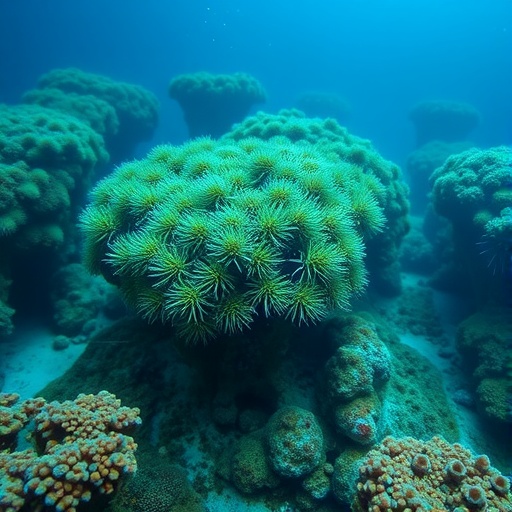In a groundbreaking study published in the prestigious journal “Coral Reefs,” researchers have unveiled new findings regarding the presence of ultraviolet (UV) filter molecules in the marine organism Paramuricea clavata, also known as the red gorgonian. This investigation, spearheaded by a team of experts including Gobbato, Becchi, and Parmegiani, underscores the significance of Marine Protected Areas (MPAs) in shielding these vibrant ecosystems in the Ligurian Sea, Italy. Given the rising concerns over marine pollution and its implications for marine biodiversity, this study sheds vital light on the intersection between human intervention and the natural marine environment.
The introduction of UV filters into the marine ecosystem is a growing concern, primarily because these chemicals are commonly found in a variety of personal care products such as sunscreens. When individuals swim or engage in water recreational activities, these filters are inevitably washed off and enter aquatic habitats. This runs the risk of adversely affecting marine organisms such as Paramuricea clavata, which play crucial roles in their ecosystems. Over time, their presence may disrupt not only the physiology of the species themselves but also the broader marine life that depends on coral reefs.
Utilizing innovative analytical techniques, the team conducted a thorough investigation into different locations along the Ligurian coast, focusing on areas designated as Marine Protected Areas. This methodological approach enabled the researchers to determine concentrations and distributions of the UV filters within the gorgonian specimens. The data was collected over multiple sampling seasons, thereby providing a comprehensive overview of the temporal variations in the presence of these chemicals.
The results of the study were striking. Certain UV filters exhibited significant levels in Paramuricea clavata specimens, indicating that even protected marine environments are not impervious to the perils of pollution. This revelation raises urgent questions regarding the efficacy of current marine conservation strategies and their ability to mitigate the effects of anthropogenic activities. The research demonstrates that MPAs, while essential for habitat protection, cannot entirely eliminate the influence of external pollutants.
Moreover, this study illustrates how the bioaccumulation of UV filters in marine organisms can have cascading effects throughout the marine food web. As these chemicals are absorbed by larger predators or filter feeders, there exists a potential for biomagnification, which could pose substantial risks to the health of marine biodiversity. Understanding these dynamics is critical for devising effective management plans that would not only protect vital species like Paramuricea clavata but also enhance the resilience of marine ecosystems amidst growing environmental pressures.
Interestingly, the research team also assessed the potential impacts of UV filters on the physiological responses of the gorgonians. Preliminary observations suggested that exposure to these pollutants might alter growth patterns, reproduction, and overall viability of the species. Such disruptions are particularly worrying, considering the ecological significance of Paramuricea clavata in forming complex habitats that support a diverse array of marine life, including fish and invertebrates.
In addition to the biological implications, the study advocates for heightened public awareness regarding the impacts of personal care products on marine ecosystems. By promoting the use of reef-safe sunscreens and encouraging responsible recreational activities, researchers hope to catalyze a cultural shift towards environmentally conscious behaviors among beachgoers and society at large. Legislative measures could also play a pivotal role, prompting changes in product formulation standards to minimize harmful ingredients.
As the researchers emphasize, multi-faceted approaches that integrate science, policy, and community engagement are essential in tackling the issue of marine pollution. The findings compel authorities to reevaluate existing regulations concerning the production and use of UV filters and call for establishing stricter guidelines in coastal regions renowned for their biodiversity.
Looking forward, this significant research paves the way for future investigations that target not only UV filters but also other emerging contaminants that pose risks to marine life. This will require extensive collaborations between various stakeholders, including governments, academic institutions, and the private sector, to address the complex challenges faced in marine conservation today.
In conclusion, the study led by Gobbato and colleagues brings to the forefront critical discussions surrounding the implications of human practices on marine ecosystems. As we strive to balance recreational enjoyment of oceanic resources with the health of marine environments, the important findings regarding UV filters in Paramuricea clavata serve as a stark reminder of our duty to protect these vulnerable species and their habitats. Protecting marine biodiversity is not merely an act of conservation; it is a comprehensive approach that encompasses environmental ethics, sustainability, and stewardship of our planet.
Strong advocacy for marine protection is paramount. The call to action must resonate across all levels of society, urging each individual to recognize the impact of their choices on ocean health. Awareness campaigns and educational outreach are vital for fostering a culture of environmental responsibility. The future of marine ecosystems, including the survival of species such as Paramuricea clavata, hinges on collective efforts to minimize pollution and uphold the integrity of the natural world.
As we digest these crucial findings, let us draw inspiration from the resilience observed in marine ecosystems and recommit ourselves to preserving the splendor of the oceans for generations to come. The message is clear: the health of our seas is intricately tied to our actions, and the time to act is now.
Subject of Research: Occurrence of UV filter molecules in marine organisms.
Article Title: Occurrence of UV filter molecules in Paramuricea clavata and the role of Marine Protected Areas (MPA) in the Ligurian Sea, Italy.
Article References:
Gobbato, J., Becchi, A., Parmegiani, A. et al. Occurrence of UV filter molecules in Paramuricea clavata and the role of Marine Protected Areas (MPA) in the Ligurian Sea, Italy.
Coral Reefs (2025). https://doi.org/10.1007/s00338-025-02730-w
Image Credits: AI Generated
DOI:
Keywords: UV filters, Paramuricea clavata, Marine Protected Areas, Ligurian Sea, marine pollution.




